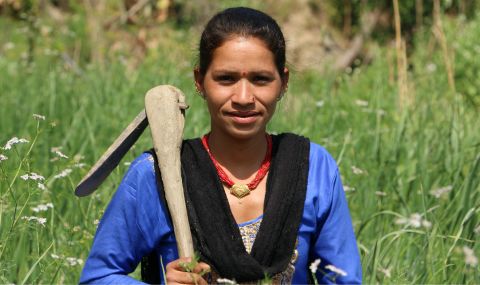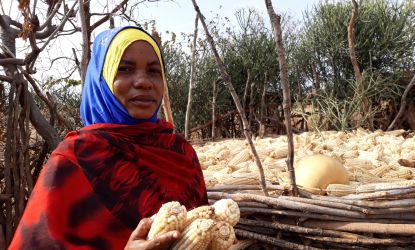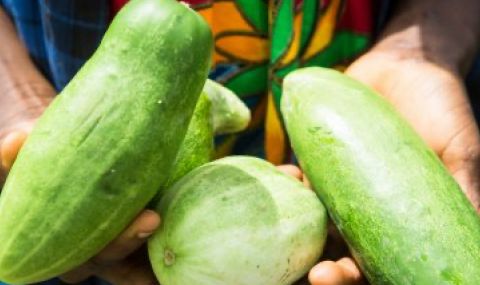Climate change and agroecology
How are industrial agricultural practices affecting the environment and climate change?
Agriculture both impacts climate change and is also affected by climate change in turn.
Many current farming practices rely heavily on industrial methods such as intensive planting of large areas of one single crop, cultivation of genetically-modified plants, harmful use of antibiotics in animal rearing, synthetic fertilizers and hybrid seeds, all designed to maximise production without considering the ecological and social consequences.4
Human activities like industrial farming, food processing and factory-farm livestock rearing have contributed to greenhouse gas emissions such as methane and carbon dioxide5 that accelerated global warming.
For example, some livestock release methane and nitrous oxide through their belches into the air which contribute to global warming. Methane is also transmitted through manure and some synthetic fertilisers release nitrous oxide emissions as well6 .
How do synthetic fertilisers contribute to climate change?
The creation of synthetic nitrogen fertilisers is energy-intensive, burns large amounts of fossil fuels and leads to high carbon dioxide emissions.
When applied to the soil, these fertilisers can release Nitrous Oxide (N2O), a highly potent greenhouse gas that has 298 times the atmospheric-warming effect of carbon dioxide.
Synthetic nitrogen fertilisers can cause stable organic matter in the soil to convert to carbon dioxide emissions in the atmosphere.
Agribusiness giants, whose core business model is built on the sales of these synthetic fertilisers assert that they offer solutions to climate change, but these claims should be treated with a high degree of scepticism.
The relationship between climate change, agriculture and food
Trees and forests are key to addressing biodiversity7 and climate change as they absorb greenhouse gases like carbon dioxide from the air and help stabilise the earth's climate.
But as demand for food grows, an increasing number of forests and natural habitats are being destroyed to pave the way for more and bigger farmlands and pastures.
Large-scale farming that allows for substantial production of crops usually encourages monoculture farming. That is, it requires growing the same, single crop repeatedly on the same soil making agriculture highly dependent on chemical pesticides and fertilisers.
This single-crop monoculture practice has left many crops weak and exposed, and their soils exhausted.
Growing the same kind of crop in the same place season after season and fertilising them with chemicals and using artificial pesticides depletes the nutrients that the plant needs. The crops become weak, stunted and come under attack from pests and diseases.8
Planting the same crops, year after year has disrupted the natural makeup of the soil affecting its nutrient content, its structure and its ability to retain water. A weaker soil can become dry, impermeable, infertile, more susceptible erosion, flooding, landslides caused by extreme weather, and unable to sustain future production of crops and ensure the food security of people and animals.
Different pests are attracted to different crops for their varying nutritional needs, so reliance on any one type of crop makes farmers vulnerable putting them at risk of losing everything9 they have carefully grown and threatening the food supply of millions of people.
It also has a significant effect on water usage –there is a disproportionally high use of water often drained from lakes, reservoirs, rivers for single crops.
Crop rotation is important to maximize the growth of plants and crops and control pest attacks.
Climate change directly affects agriculture and hunger
Climate change-related events like severe weather have a direct impact on agriculture and as a result, on our food security.
As the earth's temperature rises and moisture content in its atmosphere increases, weather patterns like droughts, heatwaves, wildfires, hurricanes, floods, landslides, storms, become more frequent, unpredictable and intense.
Not only does already fragile, weak soil stands very little chance against these potent and unusual weather patterns, but droughts and floods bring their own problems.
For example, climate change-related disasters were one of the leading causes of food crises in 2017. They make growing food less reliable, reducing access to food and increasing food prices.10
In many places that ActionAid works in Africa, Asia and Latin America, small-scale farmers have been complaining that the raining period is starting later and later in the year and ending earlier than usual.
Droughts and dry weather can result in low or irregular rainfall and cause poor pasture growth. In Somaliland, repeated spells of drought have dried out crops and fodder resulting in the death of livestock and affecting families' food supplies and livelihoods.11
Floods are caused by heavy rains and storms that make the soil too water-logged and wet for crops to grow. Without adequate soil drainage, plants cannot access the nutrients and oxygen that they need to grow.
In Bangladesh, persistent floods have wiped out crops and destroyed infrastructure blocking roads and preventing relief from reaching people putting millions of people at risk of food insecurity.12
As a result, farmers are having difficulties to define when to plant, when to harvest and crop failures are becoming more common than before.
Additionally, the recent spate of pest invasions in Africa and Asia have also been linked to climate change.
For example, the locust swarms of 2019 and 2020 that plagued East Africa and devastated thousands of hectares of natural vegetation, pastures and crops are thought to have been a result of heavy rains and unusual storm activity in the region.13
A-Z of agriculture and farming terms
Do you know what all the terms in farming and agricultural science mean? Here is a list of the various words you may come across on our climate change hub.
Agrochemical
Agrochemicals are chemical products used in farming such as fertilizers and pesticides.
Agroforestry
The practice of planting trees and shrubs alongside crops.
Biofuels
Biofuels are fuels like biodiesel and ethanol produced from
Carbon
Carbon is matter stored in soils. Increasing organic carbon in soil may decrease atmospheric carbon dioxide (which causes global warming) and increase soil quality.
Climate-resilient
Climate resilience is the capacity to deal with climate-induced events and recover from them.
Crop rotation
Crop rotation is the practice of growing different types of plants on the same part of soil.
Drought
A drought is defined as extended period - a season, a year, or several years - of unusually dry weather and low precipitation for a region, which often results in a shortage of water.
Intercropping
Growing two or more crops in close proximity.
Fertilisers
Fertilisers are food for plants and provide nitrogen, phosphorus and potassium so crops can grow faster and bigger. They can be organic or inorganic.
Flooding
Floods are described as sudden onset events where normally dry land is inundated with an overflow of accumulated water that it is unable to absorb.
Mangroves
Mangroves are trees grown in salty, coastal waters that attract fish and fight against climate change.
Monoculture
Monoculture is the practice of growing a single crop in a large area of land year after year.
Polyculture
Polyculture is the practice of growing several different types of crop on the same land either through crop rotation or intercropping.
Soil Erosion
Soil erosion is the shifting or wearing away of the topsoil by water, wind or farming.
Soil Salinity
Soil salinity is the amount of salt in the soil. The salinity of soil can increase after flooding or rising sea-water levels.
Sustainable fishing
Sustainable fishing ensures the balance of the marine ecosystem by respecting the rate at which fish reproduce, ensuring the survival of different fish species and making sure those who rely on fishing for their livelihoods can maintain their income.

Economic empowerment helps women to live a dignified life.
How does agroecology help people and the climate?
To secure access to food for everyone for years to come and to ensure we avoid the worst of climate-change-related-disasters means we need to maintain and improve our soil, water sources and biodiverse ecosystems.
We know that industrial agriculture favours large farms, encourages the use of synthetic fertilisers, chemical pesticides and weedkillers to achieve economies of scale and, as a result, disempowers small farmers, degrades the environment and makes climate change worse.
More and more, the evidence shows that small, single family-based farms that use agroecological techniques are vastly superior to industrial farms17 : they are highly efficient, sustainable, resilient to climate change, and offer multiple other social, cultural and environmental benefits.
What are agroecological principles and techniques and their benefits?
Agroecology is farming based on a combination of traditional, decentralised, community-owned and sustainable practice with science.18
- Agroecological farmers provide an answer to hunger and food sovereignty: Small-scale farmers, forest dwellers, fisherfolk and indigenous people produce 80% of the world's food but are not taken in consideration by governments and decision-makers. They are part of a localised food system that nourish and feed their communities and oppose the commodification of natural resources and farming for vast profit.
- Agroecology is kind to the soil and the environment: Agroecological techniques mirror nature's cycles, prevent soil and environmental degradation. Family farmers plant a variety of crops and rotate them to avoid soil fatigue and pest attacks. They use intercropping where a few crops are grown together or agroforestry which is the practice of combining trees with crops. Instead of chemical fertilisers, agroecological farmers use compost, permanent soil cover, green manure and many other alternatives to keep the soils healthy.
- Agroecology is more energy-efficient: it is less dependent on external inputs that demands a huge amount of fossil fuel to be produced, e.g. pesticides and fertilisers.19
- Agroecology is beneficial for farmers' health: Using natural pesticides and weed killers mean agroecological farmers avoid exposure to hazardous chemicals.
- Agroecology helps to reduce poverty and social exclusion: All these practices involve whole families and community members sharing work and promotes social cohesion.
- Agroecology reduces the worst impacts of and stabilises climate change: Agroecology promotes agricultural biodiversity (varied crops and healthy soil for example) which can increase the resilience of farmers to extreme climate events. For example, this kind of farming is able to adapt and minimise the effects of droughts and floods.20 Most importantly, organically farmed soil has increased carbon content and helps to capture carbon dioxide from the atmosphere. Hence, not only is agroecology more resistant to climate change than industrial agriculture, but it also can stabilise global warming.21
What does ActionAid do to help farmers, communities and fight climate change?
An estimated 500 million family farms represent over 90% of all farms globally and over half of these farmers are women.22
Women farmers face unique constraints because of gender bias such as not having decision-making powers, low rural wages, poor funding, lack of access to information, land and resources, unpaid care work responsibilities, and limited exposure or access to markets to sell their produce.
- ActionAid challenges industrial corporate agriculture and false solutions such as climate-smart agriculture.
- ActionAid supports women farmers’ access to markets for trade.
- ActionAid advocates for the reduction of debt and public financing for women farmers and agroecology.
- ActionAid promotes agroecology as a real alternative to industrial agriculture, which ensures food stays where it is most needed. For example, we support Cambodian women in planting mangroves to they can sustain themselves and their families and secure their livelihoods.
- ActionAid contributes to farmers’ resilience against climate change by providing them with training, tools, climate-resilient seeds, and information about sustainable practices.
- ActionAid contributes to the empowerment of women farmers so they know about their rights and are armed with all the information they need to lead change.

ActionAid trained 40-year old Pili from Tanzania on mixed farming practices.
Elias Mtinda/ActionAid
Training women in climate-resilient agriculture
I thank ActionAid for working with us in this community as many families have improved their way of farming especially how to grow varieties of crops in the same farms."
40-year-old Pili from Tanzania used to grow just one crop on one plot of land over several years. Eventually, her soil became infertile and stopped yielding crops.
ActionAid supported Pili and her community in crop rotation, the importance of growing leguminous crops, preparation and use of natural pesticides, and how to keep the soil fertile. As a result, Pili and her family harvested more produce this year than ever before.
Footnotes
- 1https://carbonmarketwatch.org/2014/11/25/promoting-climate-smart-agriculture-with-carbon-markets-would-not-be-a-smart-move/
- 2https://www.theguardian.com/global-development-professionals-network/2014/oct/17/climate-change-agriculture-bad-isnt-good
- 3http://www.fao.org/agroecology/home/en/
- 4https://www.unenvironment.org/news-and-stories/story/10-things-you-should-know-about-industrial-farming
- 5https://www.bbc.com/future/article/20190806-how-vaccines-could-fix-our-problem-with-cow-emissions#:~:text=Methane%20is%20one%20of%20the,You%20might%20also%20like%3A&text=Alongside%20carbon%20dioxide%2C%20farming%20generates,to%20the%20soil%2C%20and%20methane.
- 6https://cbmjournal.biomedcentral.com/articles/10.1186/s13021-019-0133-9
- 7http://www.fao.org/news/story/en/item/1180463/icode/
- 8http://www.fao.org/agriculture/crops/thematic-sitemap/theme/spi/scpi-home/managing-ecosystems/integrated-pest-management/ipm-how/en/
- 9https://www.sciencedaily.com/releases/2016/10/161012134054.htm
- 10https://post.parliament.uk/research-briefings/post-pn-0600/
- 11https://www.ft.com/content/c8b475b2-ebf2-11e8-89c8-d36339d835c0
- 12https://www.climatechangenews.com/2017/05/15/bangladesh-faces-food-supply-crunch-flash-floods/
- 13https://www.nature.com/articles/s41558-020-0835-8
- 14http://www.fao.org/3/ca4778en/ca4778en.pdf
- 15https://www.un.org/development/desa/dspd/wp-content/uploads/sites/22/2018/05/9.pdf
- 16http://www.ilo.org/wcmsp5/groups/public/---dgreports/---dcomm/---publ/documents/publication/wcms_457317.pdf.
- 17http://www.fao.org/fileadmin/templates/agphome/scpi/Agroecology/Agroecology_Scaling-up_agroecology_what_why_and_how_-OxfamSol-FINAL.pdf
- 18https://actionaid.org/sites/default/files/agroecology_def_web.pdf
- 19]https://www.un.org/en/chronicle/article/role-fossil-fuels-sustainable-energy-system
- 20https://www.researchgate.net/publication/242679020_Ecological_farming_Drought-resistant_Agriculture
- 21https://actionaid.org/sites/default/files/agroecology_def_web.pdf
- 22http://www.fao.org/3/ca4778en/ca4778en.pdf
Page updated 6 February 2025




